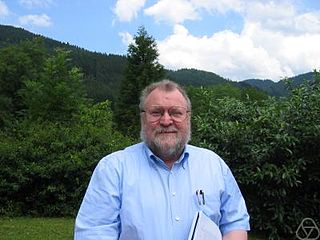
Krystyna M. Kuperberg is a Polish-American mathematician who currently works as a professor of mathematics at Auburn University, where she was formerly an Alumni Professor of Mathematics.
In mathematics, the Seifert conjecture states that every nonsingular, continuous vector field on the 3-sphere has a closed orbit. It is named after Herbert Seifert. In a 1950 paper, Seifert asked if such a vector field exists, but did not phrase non-existence as a conjecture. He also established the conjecture for perturbations of the Hopf fibration.
In mathematics, the Property P conjecture is a statement about 3-manifolds obtained by Dehn surgery on a knot in the 3-sphere. A knot in the 3-sphere is said to have Property P if every 3-manifold obtained by performing (non-trivial) Dehn surgery on the knot is not simply-connected. The conjecture states that all knots, except the unknot, have Property P.
In mathematics, Floer homology is a tool for studying symplectic geometry and low-dimensional topology. Floer homology is a novel invariant that arises as an infinite-dimensional analogue of finite-dimensional Morse homology. Andreas Floer introduced the first version of Floer homology, now called Lagrangian Floer homology, in his proof of the Arnold conjecture in symplectic geometry. Floer also developed a closely related theory for Lagrangian submanifolds of a symplectic manifold. A third construction, also due to Floer, associates homology groups to closed three-dimensional manifolds using the Yang–Mills functional. These constructions and their descendants play a fundamental role in current investigations into the topology of symplectic and contact manifolds as well as (smooth) three- and four-dimensional manifolds.
In mathematics, the Weinstein conjecture refers to a general existence problem for periodic orbits of Hamiltonian or Reeb vector flows. More specifically, the conjecture claims that on a compact contact manifold, its Reeb vector field should carry at least one periodic orbit.

Clifford Henry Taubes is the William Petschek Professor of Mathematics at Harvard University and works in gauge field theory, differential geometry, and low-dimensional topology. His brother, Gary Taubes, is a science writer.
In the mathematical theory of knots, a Berge knot or doubly primitive knot is any member of a particular family of knots in the 3-sphere. A Berge knot K is defined by the conditions:
- K lies on a genus two Heegaard surface S
- in each handlebody bound by S, K meets some meridian disc exactly once.
William Philip Minicozzi II is an American mathematician. He was born in Bryn Mawr, Pennsylvania, in 1967.
In representation theory, a branch of mathematics, θ10 is a cuspidal unipotent complex irreducible representation of the symplectic group Sp4 over a finite, local, or global field.

Helmut Hermann W. Hofer is a German-American mathematician, one of the founders of the area of symplectic topology.

Eduard J. Zehnder is a Swiss mathematician, considered one of the founders of symplectic topology.

Tamar Debora Ziegler is an Israeli mathematician known for her work in ergodic theory, combinatorics and number theory. She holds the Henry and Manya Noskwith Chair of Mathematics at the Einstein Institute of Mathematics at the Hebrew University.
Nancy Burgess Hingston is a mathematician working in differential geometry. She is a professor of mathematics at The College of New Jersey.
This is a glossary of properties and concepts in symplectic geometry in mathematics. The terms listed here cover the occurrences of symplectic geometry both in topology as well as in algebraic geometry. The glossary also includes notions from Hamiltonian geometry, Poisson geometry and geometric quantization.
Lars Håkan Eliasson is a Swedish mathematician.
Eleny-Nicoleta Ionel is a Romanian mathematician whose research concerns symplectic geometry, including the study of the Gromov–Witten invariants and Gopakumar–Vafa invariant. Among her most significant results are the construction of relative Gromov-Witten invariants of symplectic manifolds, and the proof of the vanishing in codimension at least g of the tautological ring of the moduli space of genus-g curves.
In mathematics, the Gan–Gross–Prasad conjecture is a restriction problem in the representation theory of real or p-adic Lie groups posed by Gan Wee Teck, Benedict Gross, and Dipendra Prasad. The problem originated from a conjecture of Gross and Prasad for special orthogonal groups but was later generalized to include all four classical groups. In the cases considered, it is known that the multiplicity of the restrictions is at most one and the conjecture describes when the multiplicity is precisely one.
Anton Yurevich Alekseev is a Russian mathematician.
Marius Nicolae Crainic is a Romanian mathematician working in the Netherlands.







